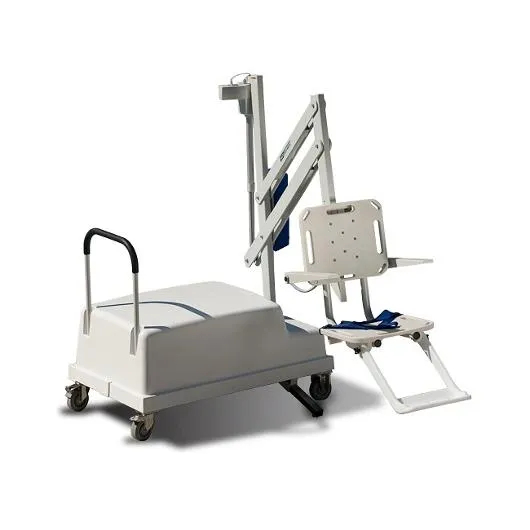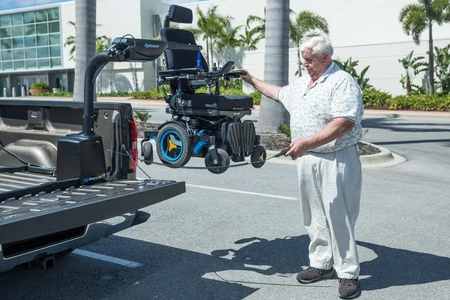Mobility should not be a luxury but a fundamental aspect of living fully, enabling everyone to explore, engage, and enjoy the world around them. For individuals facing mobility challenges, the right equipment is a bridge to making this independence a reality, with vehicle lifts playing a pivotal role. These essential devices offer the freedom to transport mobility scooters and wheelchairs easily, ensuring that trips to the grocery store, visits to family, or adventures in nature are within reach.
The Fundamentals of Vehicle Lifts
Vehicle lifts are engineered for seamless mobility, serving as an essential tool for those who utilize scooters and wheelchairs, enhancing autonomy and ensuring a world that is more accessible. This enhances the user's autonomy, making the world more accessible and navigable. Whether you're planning a local outing or a long-distance journey, a vehicle lift ensures that your mobility device is always with you, ready for use upon arrival.
- Powered Outside Lifts: These lifts attach to the vehicle's hitch and lift the mobility device from the ground to the vehicle's exterior. They're convenient for users who prefer to keep their vehicle's interior space free.
- Hybrid Lifts: A blend of interior and exterior features, hybrid lifts store the mobility device inside the vehicle but may extend outwards for easier loading and unloading. They offer protection from the elements and secure storage.
- Manual Options: Manual lifts are typically more cost-effective and require the user to physically move the mobility device onto the lift. They are suitable for lighter scooters and wheelchairs and for users capable of manual operation.
- Type of Mobility Device: It's essential to choose a lift that is compatible with your specific mobility device. The lift must accommodate the dimensions and type of your device. Each lift has its specifications and compatibility requirements, making it crucial to verify that the lift you choose is suited for your device.
- Vehicle Compatibility: Not all lifts fit all vehicles. The compatibility of a vehicle lift with your car, truck, SUV, or van depends on factors such as the vehicle's size, model, and the type of hitch or mounting system it uses.
- Weight Capacity: The weight capacity of the lift must be capable of handling the weight of your mobility device without compromise. Overloading a lift can lead to operational failures and safety hazards. It's advisable to account for the weight of the device plus any additional equipment or accessories it may carry.
By considering these factors, you can ensure that your lift selection process is informed, thoughtful, and ultimately successful in enhancing your mobility and independence.
Installation and Modifications
Installing a vehicle lift involves specific steps that vary depending on the lift type and vehicle. While some users opt for a DIY approach, professional installation is generally recommended to ensure the lift operates safely and efficiently. Professional installers can navigate the complexities of securely attaching the lift, making necessary electrical connections, and ensuring that the installation meets safety standards.
For those considering DIY installation, it's crucial to follow the manufacturer's instructions meticulously. Some lifts, especially exterior models, require minimal vehicle modifications and can be more straightforward to install. However, it's vital to assess your technical skills and the tools needed before proceeding.
Vehicle modifications might include the installation of a hitch for exterior lifts or wiring a direct connection to the vehicle's battery. Interior lifts might require more significant modifications, such as drilling into the vehicle's frame to secure the lift . Regardless of the installation method chosen, ensuring your vehicle can safely accommodate the lift is paramount.
Safety and Convenience Features
Safety features are a critical aspect of vehicle lifts, ensuring the mobility device is securely transported without risk of detachment or damage. Automatic locking mechanisms prevent the mobility device from moving during transport, while manual backup systems offer peace of mind should there be a power failure.
Convenience features significantly enhance the user experience. Remote controls allow for easy operation of the lift, reducing physical strain and making the process more accessible for individuals with limited mobility. Easy loading and unloading capabilities, such as platforms that lower to the ground or lifts that extend outside the vehicle, make the use of the lift smoother and more efficient.
Choosing a vehicle lift with the right balance of safety and convenience features can transform the transportation of mobility devices from a challenge into a seamless part of daily life.
Conclusion
Choosing the right vehicle lift is a step toward greater freedom and autonomy. A well-chosen lift is a trusty companion in your journey, providing safety, reliability, and the independence to transport your mobility aid with ease. Remember, the best vehicle lift for you is one that aligns with your mobility device, fits your vehicle, and meets your personal preferences for safety and convenience.
As you conclude your search for the perfect vehicle lift, think of it not just as a purchase but as an investment in your quality of life. When making this decision, consider choosing SpinLife as your trusted partner in the journey to mobility independence.





 Contact Us
Contact Us
 M-F 9am - 6pm ET
M-F 9am - 6pm ET
 Request parts
Request parts Request Service
Request Service





